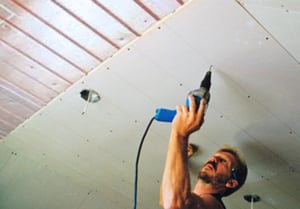While there are a number of commercial radiant ceiling cooling systems available, we are here going to address residential ceiling cooling options.
From the start, it should be recognized that residential radiant ceiling cooling can be much more complicated than radiant heating ceiling systems. This is due to the need to control the dew point in the space with ventilation and dehumidification. See below regarding design.
The Ceiling: It should be noted that the ceiling is the only effective place for radiant cooling in residential systems. Radiant floor cooling provides poor heat extraction and circulation issues that are difficult to overcome in a residential setting.
Radiant ceiling cooling works by circulating cold water through the tubing in the ceiling which employs an aluminum heat transfer surface such as Ecowarm RadiantBoard. The cooled surfaces evenly extract heat energy from a room to create a seamless sense of comfort. The same ceiling panels can also be used for heating.
Humidity Control: A concern with radiant cooling is that cool ceilings can condense and create surface damage if proper design and controls are not applied properly. This is why radiant ceiling cooling is employed most often in low humidity locals with moderate cooling loads. In those climates the system can use cool water temperatures which do not approach the dew point when surface condensations occur. Alternatively, separate humidity ventilation controls can be employed to offset these potential problems.
Ceiling Installation:
 The application of Ecowarm RadiantBoard for ceiling cooling is very similar to that for radiant ceiling heating. Much care and planning must be made to accommodate any ceiling penetrations such as lighting and sprinklers. Normally the contractor will sheath the ceiling joists with 5/8’ or ¾’ plywood and apply the Ecowarm panels to that surface according to the CAD layout provided by the factory.
The application of Ecowarm RadiantBoard for ceiling cooling is very similar to that for radiant ceiling heating. Much care and planning must be made to accommodate any ceiling penetrations such as lighting and sprinklers. Normally the contractor will sheath the ceiling joists with 5/8’ or ¾’ plywood and apply the Ecowarm panels to that surface according to the CAD layout provided by the factory.
Tip: Staple up clear plastic over the Ecowarm with tubing installed and draw on the plastic where tubes are with a marker. Tack up your sheet rock and place marked plastic on the ceiling to display tubing locations. Screw on the sheetrock avoiding tubing. With radiant ceiling cooling, the full aluminum surface of Ecowarm RadiantBoard is very important and a greater surface area of the ceiling is typically required to meet the cooling load.
The ceiling cavity must be well be insulated to assure minimum heat gain from the reverse side of the panel. The mechanical installer must be sure that air can be eliminated from the ceiling section radiant tubing using a central micro bubbler and complete system air purging on startup.
Heat pumps, whether ground source or hydronic air to water, are the most popular choice for both heating and cooling ceiling systems in residential ceiling cooling systems, however, separate chillers are sometimes employed with large radiant system.
Design
It is imperative that one have radiant ceiling cooling systems designed by a professional. The systems are typically somewhat complicated and clear instructions for the installing contractor are essential. We suggest Monterey Energy Group.
The information on this page is provided as a description of current trends in radiant heating and related equipment. We are not providing engineering advice for any particular project. The mechanical contractor and mechanical engineer can assess the different options available and apply them as they think is best for a particular project and client.
Contact Us Today For a Free Quote!
Ecowarm RadiantBoard incorporates the best balance of high performance, material quality, environmental responsibility, and cost. In short, Ecowarm RadiantBoard represents the best value in radiant board heating systems.



